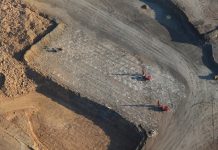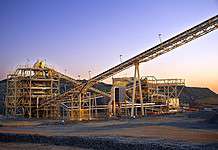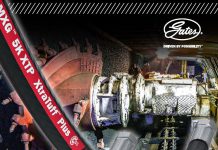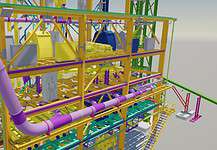Hammer longer with Rammer

One of the major causes of premature failure in rockbreakers is long cycles where an operator continues to hit the button and keep the piston striking for extended periods of time.
Correct operation, regular maintenance and visual inspections are vital in minimising the chance of rockbreaker failure, which leads to costly unscheduled downtime.
Following simple guidelines and operational techniques when using a rockbreaker can minimise component wear and deterioration, keeping operators breaking rock for longer.
Fortunately, Rammer has readily accessible resources available, including short YouTube videos, product training and manuals, that guide operators through the process of keeping their rockbreaker in prime working condition. These are supported by a dedicated global dealer network for all Rammer parts and products.
Maintaining your rockbreaker isn’t difficult if you follow some simple operational tips, from idle strokes and tool angles, to correct greasing and maintenance practices.
Less idle strokes
Frequent idle strokes can have a deteriorating effect on a rockbreaker. Rammer rockbreakers are equipped with ideal blow protection as standard to prevent idle strokes.
It’s recommended that idle blow protection is switched on during normal operation as the rockbreaker can only be initiated once the tool is pressed against an object.
Operators can turn it off when breaking soft material or in demolition applications where it is difficult to apply sufficient feeding force.
Optimal tool angles
It is advised to keep the rockbreaking tool at a 90 degree angle with the surface of the material to be split or broken. If the object moves, or its surface breaks, angle should be corrected immediately.
Continued use above or below a 90 degree angle can damage the rockbreaker and wear out bushings faster.
Striking material near an edge of a surface rather than in the centre can also increase rockbreaking efficiency for operators.
Avoid striking in the same spot for more than 15 seconds at a time. If the object does not break, or the tool does not penetrate, stop the rockbreaker and change the position of the tool.
Every 10 hours or at least once a week, it is recommended the rockbreaker tool retaining pin and the tool are removed for a condition inspection, and any burs grinded if necessary.
Visual inspections & greasing practices
Preventing unnecessary downtime through proper rockbreaker maintenance and service schedules is critical in mining applications. Rammer is committed to helping operators work safer and more productively, whilst keeping their rockbreakers in optimal condition.
Greasing, particularly keeping the tool shank well-greased during operation, is a
highly recommended maintenance strategy.
The right amount of grease depends on rockbreaker size, application, working cycles, wear rate of the tool shank and bushings, condition of the tool seal, and quality of the grease used.
The rockbreaker tool should be checked every two hours to ensure it is sufficiently greased, including the automatic grease cartridge. Operators should monitor hydraulic oil temperature, and ensure all lines and connections are secure.
The mounting hardware on the rockbreaker and carrier should be checked and tightened if required.
Every 50 hours or at least once a month, the tool shank and bushings should be inspected for wear. If the grease grooves on the tool bushing are worn, the bushing must be replaced.
Hydraulic hoses should be regularly checked and replaced if necessary, and that the rockbreaker moves normally insidethe housing, and vibration dampening elements such as pads and buffers are in good condition. The condition of wear pads and internal housing wear also require inspection. It is also advised that operators avoid using a rockbreaker with the tool submerged underwater unless previously setup for such an application.
Regular visual inspections of the rockbreaker and its components are essential.
Short & long-term storage
To protect the rockbreaker when not in use, the tool should be removed and the rockbreaker itself stored in a vertical position.
The lower end of the piston tool and tool bushings can be protected with grease.
Connections should be sealed with clean plugs to prevent oil leakage and dirt from getting into the couplings. It is also important that the rockbreaker is appropriately secured to prevent it from falling.
Preventative maintenance
The integration of Rammer’s world-first RD3 hydraulic rockbreaker monitoring technology is an effective method for operators to remotely monitor rockbreaker usage and prevent premature failure. It provides operators with detailed information in real-time via the cloud based SAM platform, allowing them to manage service periods and minimise machinery downtime by scheduling maintenance during times that have minimal impact on production.
Product Line Lifecycle Manager for Rammer Rockbreakers, Esa Sjönberg says it’s no surprise that their large rockbreaker range is a reliable choice for miners due to the robust components and high-quality steel used, which offer extra durability throughout the breaker lifecycle.
“Despite our innovative manufacturing processes and high-quality materials, maximising rockbreaking effectiveness relies on correct working methods and maintenance that not only improve productivity, but help operators increase their equipment service life. That’s why our team is dedicated to educating operators on how to achieve the most from their rockbreakers.” AMR
Unrivalled Performance
 For over 40 years, Rammer rockbreakers have proven the reliable solution for the toughest mining, quarrying and demolition applications. The company knows that getting the most out of your rockbreakers comes down to more than just the right product. It requires an in-depth knowledge of the science behind the product, its materials and components, which all combine to maximise service life.
For over 40 years, Rammer rockbreakers have proven the reliable solution for the toughest mining, quarrying and demolition applications. The company knows that getting the most out of your rockbreakers comes down to more than just the right product. It requires an in-depth knowledge of the science behind the product, its materials and components, which all combine to maximise service life.
Featuring advanced hydraulics, quality materials, and excellent power-toweight ratio, Rammer rockbreakers have gained a reputation for safety and reliability, particularly in hard and abrasive Australian environments.
Their flagship rockbreakers and hydraulic booms are purpose-built to work safely and efficiently. From major excavation and clearing works, to the effortless breaking of hard rock, concrete, reinforced structures, asphalt surfaces, or even frozen ground, Rammer rockbreakers are designed for power and productivity in the most challenging conditions.
For more information, or to locate your nearest dealer, visit https://www.rammer.com/
Rammer authorised dealer network in Australia
- VIC/SA/TAS: Walkers Hammers
- NSW: Groundtec
- QLD, NT, PNG: QLD Rock Breakers
- WA: Total Rockbreaking Solutions






















